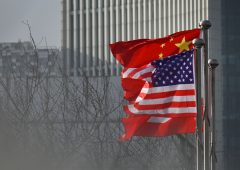Key Takeaways from the Latest Federal Reserve Meeting
26.11.2024 21:11 2 min. read Alexander Stefanov
The Federal Reserve’s minutes from November 6-7, closely watched by both the cryptocurrency and traditional markets, have shed light on the central bank's ongoing policy considerations.
Officials discussed the balance between maintaining restrictive measures and transitioning to a more neutral stance, depending on economic conditions. Several members noted that keeping interest rates at restrictive levels could be necessary if inflation remains persistent. Others suggested that if the labor market weakens or economic activity falters, easing policies might accelerate.
A recurring theme was uncertainty about the “neutral” interest rate, prompting many officials to support a gradual reduction in the restrictiveness of monetary policy. Some participants even observed that risks to the labor market and overall economy appear to have diminished.
Public comments since the meeting indicate a divide among Fed officials. Some believe the economy is nearing a neutral policy stance, signaling an end to further rate reductions. Others see the potential need for a longer period of cuts.
A week after the meeting, Fed Chair Jerome Powell emphasized caution, stating that the economy does not currently indicate an urgent need to lower rates further. He highlighted the central bank’s intention to carefully evaluate future policy decisions.
The meeting minutes also reveal policymakers’ deliberations over data showing stronger-than-expected economic growth and persistently high inflation. Despite a slowdown in job creation during October, officials largely agreed that the U.S. economy continues to exceed expectations, underscoring the complexity of setting monetary policy in the current climate.
-
1
China Quietly Advances Yuan as Dollar Alternatives Gain Ground
20.05.2025 17:00 2 min. read -
2
Economic Instability and Political Shift Fueling Bitcoin’s Rise – Galaxy Digital CEO
23.05.2025 12:00 2 min. read -
3
Trump Renews Attack on Fed Chair, Calls for Immediate Rate Cuts
18.05.2025 8:00 1 min. read -
4
Japan’s Inflation Hits 3.5% as Food Prices Soar and Tariff Risks Loom
23.05.2025 21:00 1 min. read -
5
US Dollar Dominance Under Threat Amid Yuan’s Global Ambitions
22.05.2025 14:00 2 min. read
Tariffs Threaten to Stall U.S. Growth in 2025, Recovery Not Expected Until 2026
The U.S. economy may be closer to a downturn than many realize, according to Jay Bryson, chief economist at Wells Fargo.
Dollar Faces Deep Decline as Fed Cuts Pressure Currency, Warns Morgan Stanley
Morgan Stanley has issued a cautionary outlook on the U.S. dollar, predicting a major decline over the coming year as Federal Reserve rate cuts take hold.
Trillions in Debt Payments Could Break U.S. Economy, Ray Dalio Predicts
Legendary investor Ray Dalio has issued a stark warning about the trajectory of U.S. government finances, suggesting the country is drifting toward a series of severe economic shocks unless its debt spiral is urgently addressed.
Wall Street Veteran Warns Tariffs Could Disrupt AI-Driven Market Rally
Steve Eisman, the famed investor known for forecasting the 2008 housing collapse, is sounding the alarm—not on overvalued tech stocks or interest rates, but on the escalating risk of global trade disputes.
-
1
China Quietly Advances Yuan as Dollar Alternatives Gain Ground
20.05.2025 17:00 2 min. read -
2
Economic Instability and Political Shift Fueling Bitcoin’s Rise – Galaxy Digital CEO
23.05.2025 12:00 2 min. read -
3
Trump Renews Attack on Fed Chair, Calls for Immediate Rate Cuts
18.05.2025 8:00 1 min. read -
4
Japan’s Inflation Hits 3.5% as Food Prices Soar and Tariff Risks Loom
23.05.2025 21:00 1 min. read -
5
US Dollar Dominance Under Threat Amid Yuan’s Global Ambitions
22.05.2025 14:00 2 min. read


